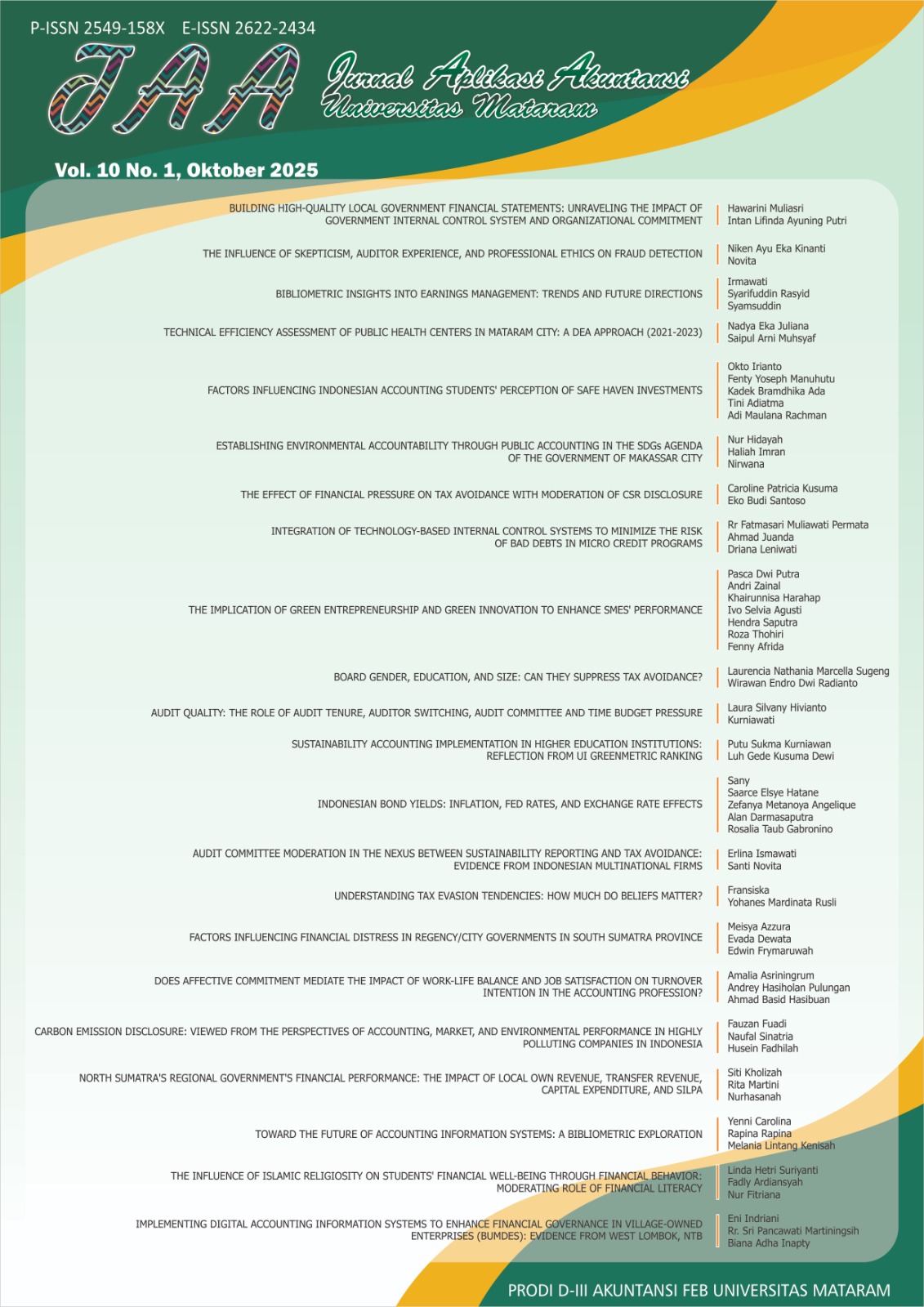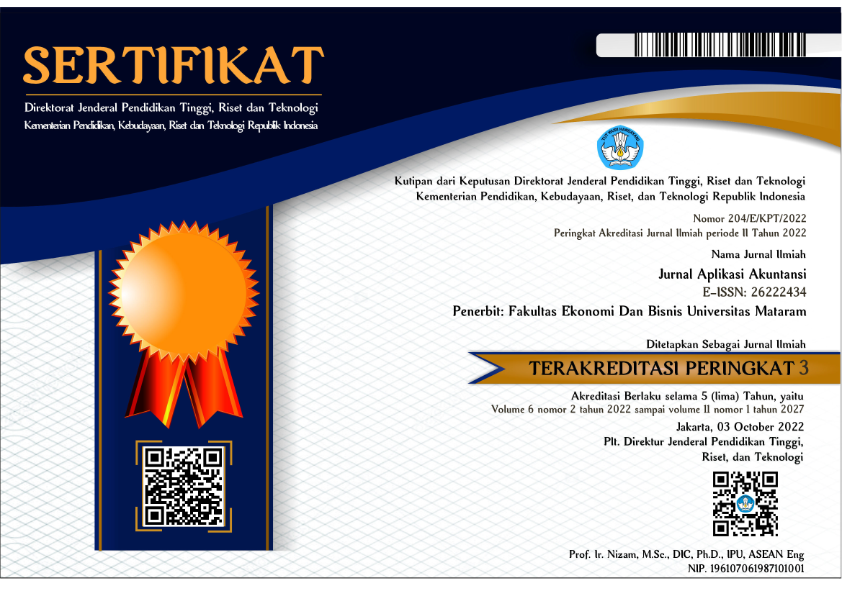FACTORS INFLUENCING INDONESIAN ACCOUNTING STUDENTS' PERCEPTION OF SAFE HAVEN INVESTMENTS
DOI:
https://doi.org/10.29303/jaa.v10i1.651Keywords:
trade war, safe haven, investment perception, financial literacyAbstract
This study aims to identify and analyze the factors that influence the perception of Accounting students in Indonesia towards safe haven investments in the context of global economic uncertainty due to the US-China trade war. Continued economic uncertainty encourages investors to seek hedging instruments, but the understanding of the younger generation as prospective financial practitioners towards safe havens is still limited. This explanatory quantitative study uses primary data from 168 accounting students through a structured questionnaire. Data analysis uses Structural Equation Modeling with Partial Least Squares (SEM-PLS) to test the effect of financial knowledge level, investment experience, risk tolerance, and exposure to market information on safe haven perceptions. The results show that the level of financial knowledge has the most significant positive effect on safe haven perceptions, followed by investment experience and exposure to market information, which also have a positive impact. Conversely, risk tolerance has a significant adverse impact on safe haven perceptions. The research model explains 54.7% of the variance in safe haven perceptions with good predictive relevance. These findings imply the need to strengthen financial literacy and experiential learning in the accounting curriculum to prepare graduates with a comprehensive understanding of investment risk management in an era of global economic uncertainty.
References
Amirtha, R. (2024). Financial Literacy for the Future: Preparing Individuals for Economic Success. Recent Research Reviews Journal, 3(2), 381–396. https://doi.org/10.36548/rrrj.2024.2.006
Anas, M., Bouri, E., & Shahzad, S. J. H. (2024). A Bibliometric analysis of literature on hedge and safe haven assets. Journal of Economic Surveys. https://doi.org/10.1111/joes.12677
Anggarani, N. K. D. M. (2024). Financial Literacy, Risk Tolerance, Return, and Interest in Student Investment. Transekonomika: Akuntansi, Bisnis, Dan Keuangan, 4(6), 1026–1040. https://doi.org/10.55047/transekonomika.v4i6.755
Botman, D. P. J., Carvalho Filho, I. E., & Lam, R. W. (2013). The Curious Case of the Yen as a Safe Haven Currency: A Forensic Analysis. IMF Working Papers, 13(228), 1. https://doi.org/10.5089/9781475513424.001
Boubaker, H., Cunado, J., Gil-Alana, L. A., & Gupta, R. (2020). Global crises and gold as a safe haven: Evidence from over seven and a half centuries of data. Physica A: Statistical Mechanics and Its Applications, 540, 123093. https://doi.org/10.1016/j.physa.2019.123093
Corter, J. E., & Chen, Y.-J. (2006). Do Investment Risk Tolerance Attitudes Predict Portfolio Risk? Journal of Business and Psychology, 20(3), 369–381. https://doi.org/10.1007/s10869-005-9010-5
Cui, J. (2024). Behavioral Finance: The Impact of Investor Expectation on Financial Decision-Making. Advances in Economics, Management and Political Sciences, 79(1), 39–43. https://doi.org/10.54254/2754-1169/79/20241874
Danthine, J.-P., & Danthine, S. (2018). On the rewards to international investing: a safe haven currency perspective. Swiss Journal of Economics and Statistics, 154(1), 14. https://doi.org/10.1186/s41937-017-0005-8
Dhiran, D. M., & Jayabalan, J. (2024). Exploring the Impact of Financial Literacy on Investment Behavior among College Students. Shanlax International Journal of Management, 11(S1-Mar), 44–50. https://doi.org/10.34293/management.v11iS1-Mar.8057
Divanoglu, S. U., & Bagci, H. (2018). Determining the Factors Affecting Individual Investors' Behaviours. International Journal of Organizational Leadership, 7(3), 284–299. https://doi.org/10.33844/ijol.2018.60407
Dua, T. D., Sanga, K. P., & Goo, E. E. K. (2024). Pengaruh Literasi Keuangan dan Perilaku Keuangan terhadap Keputusan Investasi Mahasiswa Universitas Nusa Nipa. Jurnal Riset Ekonomi Dan Akuntansi, 2(3), 572–595. https://doi.org/10.54066/jrea-itb.v2i3.2432
Elsa, E. J., & Mayangsari, S. (2022). Pengaruh Ilmu, Literasi keuangan, dan Diseminasi Pasar Modal Terhadap Minat Mahasiswa Akuntansi dalam Berinvestasi di Pasar Modal. Jurnal Ekonomi Trisakti, 2(2), 543–554. https://doi.org/10.25105/jet.v2i2.14341
Fajgelbaum, P. D., & Khandelwal, A. K. (2022). The Economic Impacts of the US–China Trade War. Annual Review of Economics, 14(1), 205–228. https://doi.org/10.1146/annurev-economics-051420-110410
Febriyana, N., & Hwihanus, H. (2023). Pengaruh Edukasi Pasar Modal, Ekspektasi Return, dan Persepsi Risiko Terhadap Minat Investasi Mahasiswa Pada Instrumen Pasar Modal. GEMILANG: Jurnal Manajemen Dan Akuntansi, 4(2), 48–63. https://doi.org/10.56910/gemilang.v4i2.1174
Feder-Sempach, E., Szczepocki, P., & Bogołębska, J. (2024). Global uncertainty and potential shelters: gold, bitcoin, and currencies as weak and strong safe havens for main world stock markets. Financial Innovation, 10(1), 67. https://doi.org/10.1186/s40854-023-00589-w
Fitriyah, A. T., & Rahmawati, N. (2022). Digital Platform, Financial Literacy and Motivation on Generation Z's Decision to Invest in Islamic Stocks: A Structural Equation Modelling Analysis. Muqtasid: Jurnal Ekonomi Dan Perbankan Syariah, 13(2), 112–126. https://doi.org/10.18326/muqtasid.v13i2.112-126
Gobel, M. S., Gaffar, & Usman. (2024). Pengaruh Pemahaman Investasi dan Tingkat Risiko terhadap Keputusan Investasi Mahasiswa di Pasar Modal (Studi pada Mahasiswa Akuntansi, Universitas Negeri Gorontalo). Jurnal Mahasiswa Akuntansi, 3(3), 218–233.
Grable, J. E. (2000). Financial Risk Tolerance and Additional Factors That Affect Risk Taking in Everyday Money Matters. Journal of Business and Psychology, 14(4), 625–630. https://doi.org/10.1023/A:1022994314982
Gürkaynak, R. S., Sack, B., & Swanson, E. (2005). The Sensitivity of Long-Term Interest Rates to Economic News: Evidence and Implications for Macroeconomic Models. American Economic Review, 95(1), 425–436. https://doi.org/10.1257/0002828053828446
Hoffstein, C., Sibears, J., & Faber, N. (2016). A Modern, Behavior-Aware Approach to Asset Allocation and Portfolio Construction. SSRN Electronic Journal. https://doi.org/10.2139/ssrn.2881609
Jäggi, A., Schlegel, M., & Zanetti, A. (2019). Macroeconomic surprises, market environment, and safe-haven currencies. Swiss Journal of Economics and Statistics, 155(1), 5. https://doi.org/10.1186/s41937-019-0031-9
Jariyah, A., Diana, N., & Mawardi, M. C. (2023). Pengaruh Informasi Akuntansi, Profil Risiko Investor, dan Perilaku Investor Saham Individual Terhadap Keputusan Investasi Investor Mahasiswa di Universitas Islam Malang. In e_Jurnal Ilmiah Riset Akuntansi (Vol. 12). http://jim.unisma.ac.id/index.php/jra,
Kahneman, D., & Tversky, A. (1979). Prospect Theory: An Analysis of Decision under Risk. Econometrica, 47(2), 263. https://doi.org/10.2307/1914185
Karo, G., Barus, H. G., Salsabila, N. L., Harahap, R. N. A., Syahutra, R., & Rayoga, R. B. (2025). Analyzing Factors Influencing Investment Decisions in the Indonesian Capital Market. Jurnal Ecoment Global, 10(1), 81–89. https://doi.org/10.36982/jeg.v10i1.5383
Kopyl, K. A., & Lee, J. B.-T. (2016). How safe are the safe haven assets? Financial Markets and Portfolio Management, 30(4), 453–482. https://doi.org/10.1007/s11408-016-0277-5
Krische, S. D. (2019). Investment Experience, Financial Literacy, and Investment‐Related Judgments. Contemporary Accounting Research, 36(3), 1634–1668. https://doi.org/10.1111/1911-3846.12469
Krishnaprabha, S. (2024). Exploring the Impact of Social Media on Investment Behaviour of Young Investors. Journal of Informatics Education and Research, 4(3). https://doi.org/10.52783/jier.v4i3.1860
Li, L., & Chen, C. R. (2024). When Safe-Haven Asset Is Less than a Safe-Haven Play. Journal of Financial Econometrics, 22(4), 808–838. https://doi.org/10.1093/jjfinec/nbad009
Liu, W. (2020). Are Gold and Government Bond Safe‐Haven Assets? An Extremal Quantile Regression Analysis. International Review of Finance, 20(2), 451–483. https://doi.org/10.1111/irfi.12232
Lusardi, A. (2015). Financial Literacy Skills for the 21st Century: Evidence from PISA. Journal of Consumer Affairs, 49(3), 639–659. https://doi.org/10.1111/joca.12099
Lusardi, A. (2019). Financial literacy and the need for financial education: evidence and implications. Swiss Journal of Economics and Statistics, 155(1), 1. https://doi.org/10.1186/s41937-019-0027-5
Markowitz, H. (1952). Portfolio Selection. The Journal of Finance, 7(1), 77. https://doi.org/10.2307/2975974
Mawaddah, N., & Oktaviani, A. (2024). Impact of Heuristic Behavior and Risk Perception on Investment Decisions by Young Investors. MAKSIMUM, 14(2), 220. https://doi.org/10.26714/mki.14.2.2024.220-230
Mrowiec, M. (2024). Safe-Haven Currencies During Financial Market Instability in The 21st Century. Scientific Papers of Silesian University of Technology Organization and Management Series, 2024(208), 385–398. https://doi.org/10.29119/1641-3466.2024.208.22
Mulyani, N. P., & Wirawati, N. G. P. (2024). Impact of Investment Knowledge, Financial Literacy, and Minimum Capital Requirements on Student Stock Investment Interest. E-Jurnal Akuntansi, 34(7), 1746. https://doi.org/10.24843/EJA.2024.v34.i07.p09
Murhadi, W. R., Irvansyah, D., & Mahadwartha, P. A. (2024). The Effect of Overconfidence, Representative, Anchoring, and Availability Biases on Investment Decisions and Market Efficiency. Matrik : Jurnal Manajemen, Strategi Bisnis Dan Kewirausahaan, 125. https://doi.org/10.24843/MATRIK:JMBK.2024.v18.i02.p03
Oktaviani, A., & Mawaddah, N. (2024). Young Investor's Investment Decision Making: The Influence of Heuristic Behavior, Risk Perception, and Herding Bias. Jurnal Akuntansi Aktual, 58. https://doi.org/10.17977/um004v11i12024p058
Pandiangan, T. M., Sihite, S., Simbolon, A. P., Manik, V. L. B., Tamba, I. N., & Simanjuntak, R. T. R. (2023). Implikasi Perang Dagang AS-China Terhadap Stabilitas Ekonomi Indonesia. Indo-MathEdu Intellectuals Journal, 4(3), 1927–1936. https://doi.org/10.54373/imeij.v4i3.447
Pemayun, A. A. G. A. W., & Yasa, G. W. (2020). Safe haven investment during turbulent conditions in Indonesia and Philippines capital market. International Research Journal of Management, IT and Social Sciences, 7(3), 137–143. https://doi.org/10.21744/irjmis.v7n3.934
Qu, K. (2024). Strategies for Mitigating and Managing Risks in Bank Investments. Scholarly Review Journal, SR Online: Showcase(Fall 2024). https://doi.org/10.70121/001c.123781
Reski, M., & Amrullah, A. (2024). Investment Choices in the Young Generation: A Behavioral Economics Approach Using Prospect Theory. Fundamental and Applied Management Journal, 2(1). https://doi.org/10.61220/famj.v2i1.2244
Sharma, M., Damseth, A., & Shyam, I. (2024). Financial Literacy and Investment Decisions among Youth: An Analysis Using Prism of Age. International Journal of Current Science Research and Review, 07(10). https://doi.org/10.47191/ijcsrr/V7-i10-72
Singh, P. K., & Singh, I. (2024). Financial literacy education: Bridging the gap between theory and practice. International Journal of Humanities and Education Research, 6(1), 01–05. https://doi.org/10.33545/26649799.2024.v6.i1a.58
Thuy, V. L. T., Oanh, T. T. K., & Ha, N. T. H. (2024). The roles of gold, US dollar, and bitcoin as safe-haven assets in times of crisis. Cogent Economics & Finance, 12(1). https://doi.org/10.1080/23322039.2024.2322876
Tronzano, M. (2020). Safe-Haven Assets, Financial Crises, and Macroeconomic Variables: Evidence from the Last Two Decades (2000–2018). Journal of Risk and Financial Management, 13(3), 40. https://doi.org/10.3390/jrfm13030040
Warjono, D. K., Ika Prajawati, M., & Sulhan, M. (2024). Risk Perception and Return Expectation on Investment Decisions in the Capital Market. Jurnal Inovasi Pendidikan Ekonomi (JIPE), 14(2), 157. https://doi.org/10.24036/011315280
Downloads
Published
How to Cite
Issue
Section
License
Copyright (c) 2025 Okto Irianto, Fenty Yoseph Manuhutu, Kadek Bramdhika Ada, Tini Adiatma, Adi Maulana Rachman

This work is licensed under a Creative Commons Attribution-ShareAlike 4.0 International License.









